黄土中宇宙成因核素10Be提取条件检验
赵国庆,张 丽,孔祥辉,付云翀,杜雅娟
1.中国科学院地球环境研究所 黄土与第四纪地质国家重点实验室,陕西省加速器质谱技术及应用重点实验室,西安 710061
2.西安加速器质谱中心,西安 710061
黄土中宇宙成因核素10Be提取条件检验
赵国庆1,2,张 丽1,2,孔祥辉1,2,付云翀1,2,杜雅娟1,2
1.中国科学院地球环境研究所 黄土与第四纪地质国家重点实验室,陕西省加速器质谱技术及应用重点实验室,西安 710061
2.西安加速器质谱中心,西安 710061
鉴于利用中国黄土中的宇宙成因核素10Be示踪高分辨率的古地磁场变化研究工作需要高精度、低本底的化学实验结果,为获得现有样品制备流程的详细数据并优化实验流程,文章对酸提取效率进行了检验。通过采用不同温度、不同酸度在加热板和微波消解仪下的提取效率对比检验,获得了不同条件下的可靠实验数据,检验了现有流程提取两次可将样品中90%以上的10Be提取出来,达到实验要求。
黄土;10Be;BeO
10Be主要是由高能宇宙射线与大气中的氮、氧发生散裂反应生成,具有半衰期较长、地球化学行为较稳定等特点,在深海和冰芯的环境示踪研究中涵盖了全球变化研究的多个领域。因10Be产率与地磁场强度变化呈反相关关系,可捕捉弱地磁场信号的变化,国际上已成功运用深海和冰芯中的10Be重建了古地磁场变化曲线(Frank et al,1997;Wagner et al,2000)。
中国黄土10Be研究起步于20世纪80年代(Shen,1986),主要开展大气成因10Be赋存状态和地球化学行为研究(沈承德等,1989a;顾兆炎等,2000),后拓展至定年和古气候等领域(沈承德等,1989b)。但鉴于黄土来源及其组分的复杂性,直到近年Zhou et al(2007a,2007b,2015)建立的数理方法解决了将黄土10Be中微弱的地磁场信号分离出来的关键性问题,中国黄土10Be示踪高分辨率古地磁场变化的研究才取得进展(赵国庆等,2010;周卫健等,2010;孔祥辉等,2016),并成功重建了过去8万年(Zhou et al,2007a)和13万年(Zhou et al,2010)以来的古地磁场变化曲线。随着研究工作的开展,为检验实验工作的可靠性(武振坤等,2008)并探索提高实验的精度和效率,笔者进行了相关实验探索,以期为黄土10Be样品制备工作提供参考。
1 黄土中10Be提取效率对比实验
1.1 仪器与装置
实验工作在中国科学院地球环境研究所10Be实验室完成。
微控数显电热板为LabTech公司制造的FG20A型;离心机为上海安亭科学仪器厂制造的LXJ-ⅡB型;AR 2140电子天平(OHAUS公司)(量程210 g,可读性0.0001 g);微波萃取仪器为CEM MARS密闭微波消解仪;实验用水为美国Millipore公司制造的Milli-Q超纯水设备生产。
1.2 实验内容
实验内容主要包括四部分:
(1)现有实验流程中样品的提取效率;
(2)不同温度条件下提取效率检验;
(3)不同酸浓度条件下提取效率检验;
(4) 微波萃取不同浓度酸条件下的对比检验。
1.3 实验流程
将黄土、古土壤样品烘干后研磨过60目筛,储存于5 mL冷冻管内。
(1)取黄土和古土壤样品各1 g,分别放入100 mL 的Tefl on烧杯,加入3 mL去离子水和0.5 mg的9Be载体,加入3 mL双氧水静置至反应完全,加入12 mol · L-1的盐酸浸泡24 h,离心收集上清液后按图1流程进行制样,即获得一次提取结果。将离心沉淀搅匀加入10 mL的6 mol · L-1的盐酸浸泡24 h,再次重复提取两次后,将离心沉淀消解。共获得4次提取结果,以检验现实验流程对10Be的提取效率。
(2)取黄土和古土壤样品各1 g,同上流程将样品提取3次后,再次用10 mL的6 mol · L-1的盐酸浸泡24 h后提取,共获得4次提取结果,交叉检验实验结果。
(3)取黄土和古土壤样品各1 g,同上流程加入去离子水、9Be载体、双氧水、盐酸后置于加热板上在不同的温度(50℃、70℃)条件下每4 h提取一次,共提取2次,检验温度对提取效率的影响。
(4)取黄土和古土壤样品各1 g,同上流程加入去离子水、9Be载体、双氧水后,再分别加入1 mol · L-1、2 mol · L-1、4 mol · L-1、6 mol · L-1、8 mol · L-1不同浓度的盐酸,浸泡24 h后提取一次,共提取2次,获得提取效率最高时的盐酸浓度。
(5)取黄土和古土壤样品各0.5 g,应用微波消解仪将样品在4 mol · L-1、6 mol · L-1、8 mol · L-1、10 mol · L-1、12 mol · L-1不同浓度的盐酸条件下萃取一次,检验在微波条件下不同浓度酸的提取结果。
将提取实验的上清液按照武振坤等(2008)建立的实验流程进行制样,制备后在西安加速器质谱中心进行测量。
2 结果与讨论
2.1 黄土中10Be提取效率对比实验结果
对加速器测量后数据进行计算,结果见表1。
2.2 黄土中10Be提取效率对比实验结果分析
2.2.1 样品消解提取结果
为检验现有实验流程两次酸提取的效率,使用6 mol · L-1盐酸对样品进行提取三次后消解。如图2、图3所示,通过两次酸提取,黄土和古土壤样品中10Be的提取效率分别为93%和88%,即两次酸提取10Be的提取率约90%。
2.2.2 样品多次提取结果
使用6 mol · L-1盐酸对样品进行四次提取(假设提取完全),结果显示,经过两次酸提取可将黄土中91%、古土壤中87%的10Be提取出来(图4,图5),与样品消解提取结果基本一致,验证了实验工作的可靠性。
通过上述两次实验的对比检验,验证了两次酸提取可将样品中90%的10Be提取出来,现有实验流程在酸提取后再次用去离子水对样品进行洗涤,可保证90%以上的提取率。实验在获得了提取步骤详细数据的同时,也验证了现有流程每一步骤的存在都是必不可少的。实验结果中古土壤样品的提取比率没有黄土样品的比率高,造成这种结果的原因推测是古土壤中粘土矿物等成分较复杂造成的。
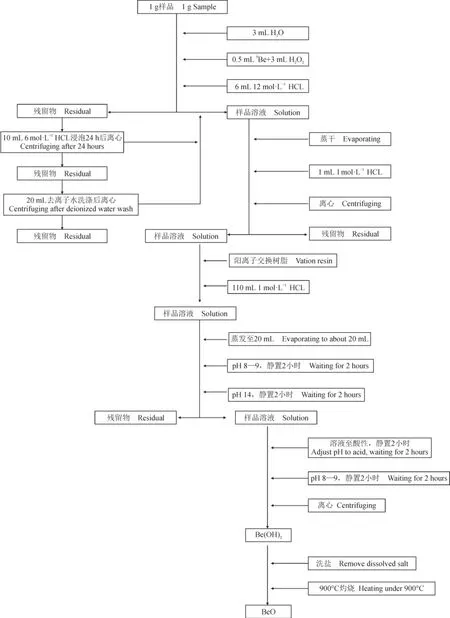
图 1 BeO样品制备的实验流程Fig.1 The experimental process of preparation BeO
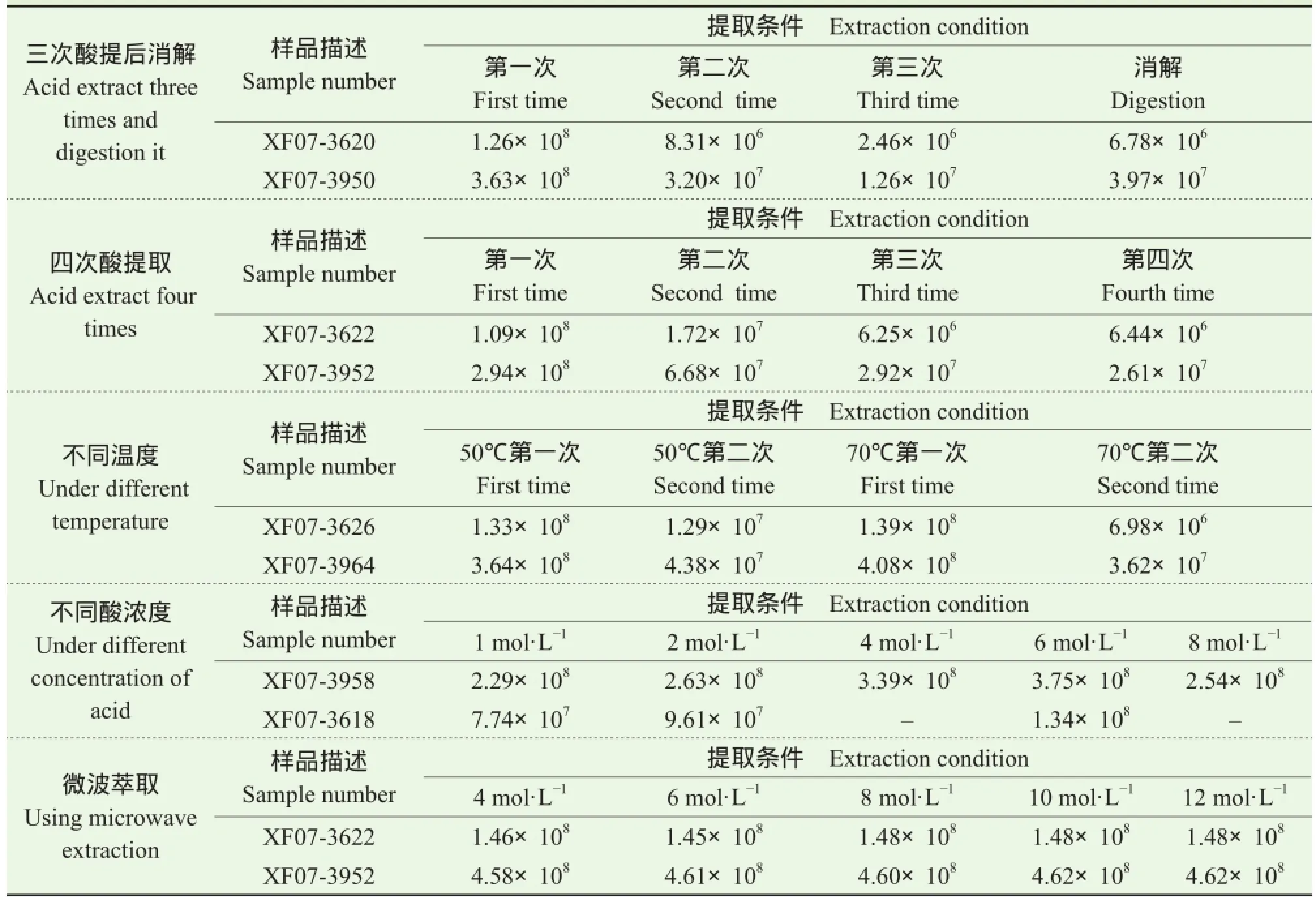
表1 黄土中10Be提取效率对比实验结果Tab.1 The experimental results of10Be extraction effi ciency in the loess /(atoms· g-1)

图2 黄土样品提取效率Fig.2 The extraction ratio of loess
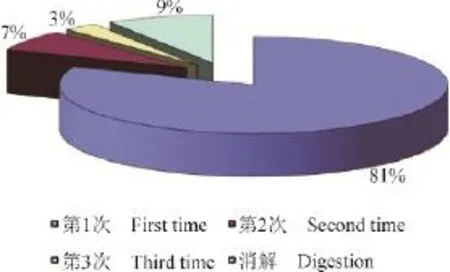
图3 古土壤样品提取效率Fig.3 The extraction ratio of paleosol

图4 黄土样品提取效率Fig.4 The extraction ratio of loess
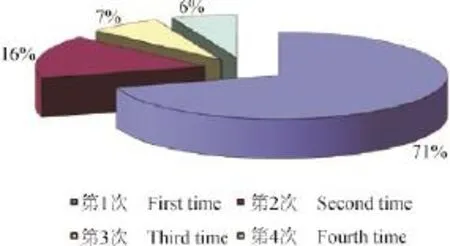
图5 古土壤样品提取效率Fig.5 The extraction ratio of paleosol
2.2.3 温度对样品提取的影响
由多次提取实验结果得知,在常温下提取两次可将样品中约90%的10Be提取出来。为检验温度条件对提取结果的影响,采用在50℃和70℃条件下对黄土和古土壤样品进行两次提取(每4 h提取一次)。由结果得知黄土样品在50℃和70℃条件下提取结果相同(图6),显示温度对酸提取结果基本无影响,验证了现有流程中采用常温条件下进行酸提取步骤的可靠性。古土壤样品在50℃和70℃条件下结果分别为4.08×108atoms · g-1和4.44× 108atoms · g-1(图6),70℃条件下结果增高,应是高温影响到粘土矿物等成分的分解造成10Be提取效率的增高,这也解释了常温提取时古土壤提取效率低于黄土提取效率。
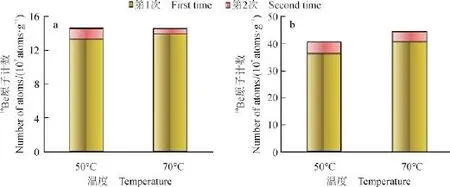
图6 不同温度条件下的提取结果(a:黄土;b:古土壤)Fig.6 The extraction results under different temperature conditions (a: loess; b: paleosol)
2.2.4 酸浓度对样品提取的影响
对古土壤样品分别用1 mol · L-1、2 mol · L-1、4 mol · L-1、6 mol · L-1、8 mol · L-1的盐酸条件下浸泡,结果显示6 mol · L-1盐酸对古土壤中10Be的提取效率最高(图7)。用黄土样品进行验证,结果与古土壤样品一致(图7)。此条件实验验证了前人工作的可靠性,因此对不同黄土粒径中10Be的赋存不再进行验证,认为10Be主要吸附和结合在风化过程中形成的细粒级粘土矿物中(Shen,1986;沈承德等,1989b)。
2.2.5 微波萃取样品结果对比
将4 mol · L-1、6 mol · L-1、8 mol · L-1、10 mol · L-1、12 mol · L-1浓度的盐酸分别加入装有0.5 g黄土样品的消解罐中,在140℃条件下萃取15 min,数据结果基本一致,显示不同酸浓度在高温高压下对样品提取结果基本没有影响。
与四次提取实验结果对比,微波萃取黄土样品比四次提取实验提取量平均高5.6%,古土壤样品提取量平均高10.8%,即在高温高压下不仅将细颗粒表面吸附的10Be,还可将粘土矿物等各种成分间裹含的10Be提取出来。

图7 不同浓度盐酸提取黄土-古土壤中10Be的结果Fig.7 The extraction results of10Be in loess-paleosol sequence with different concentrations of hydrochloric acid
3 结语
应用10Be示踪高分辨率的古地磁场变化研究离不开高精度的实验数据支撑,对现有实验流程中样品提取的比率、不同浓度酸条件下加热板和微波萃取提取效率进行了检验。通过各项条件实验,验证了现有流程酸提取两次后水洗即可将样品中90%以上的10Be提取出来,达到了实验要求。
实验中有些问题还有待进一步讨论:
(1)鉴于样品量的原因五次条件实验用了四组不同的样品进行检验,若采用同一样品可获得各项条件结果的纵向对比。
(2)古土壤样品提取结果随温度的增高而增加,而微波萃取结果基本一致,可进一步探讨提取的临界温度。
顾兆炎, Lal D, 郭正堂,等. 2000.黄土高原黄土和红粘土10Be地球化学特征 [J]. 第四纪研究, 20(5): 409 – 422. [Gu Z Y, Lal D, Guo Z T, et al. 2000. Geochemistry of cosmogenic10Be in loess-paleosol sequences and red clay in the Loess Plateau [J]. Quaternary Sciences, 20(5): 409 – 422.]
孔祥辉, 周卫健, 武振坤, 等. 2016. 大气生成宇宙成因核素10Be在中国黄土中的应用研究进展[J] . 地球环境学报, 7(3): 227 – 237. [Kong X H, Zhou W J, Wu Z K, et al. 2016. Review on the application of the atmospheric produced10Be in Chinese loess [J]. Journal of Earth Environment, 7(3): 227 – 237.]
沈承德, 刘东生, Beer J, 等. 1989a.晚更新世黄土堆积物中的10Be记录[J]. 第四纪研究, 2: 169 – 176. [Shen C D, Liu T S, Beer J, et al. 1989a.10Be record in the Late Pleistocene loess deposits [J]. Quaternary Sciences, 2: 169 – 176.]
沈承德, 刘东生, Beer J, 等. 1989b.10Be与黄土堆积演化[J].
中国科学B, 7: 744 – 751. [Shen C D, Liu T S, Beer J, et al. 1989b.10Be and deposits evolution of loess [J]. Science in China(Series B), 7: 744 – 751.]
武振坤, 周卫健, 刘 敏, 等. 2008. 黄土样品的BeO制备及AMS测量[J]. 核技术, 31(6): 427 – 432. [Wu Z K, Zhou W J, Liu M, et al. 2008. BeO preparation and AMS measurement result for loess samples [J]. Nuclear Techniques, 31(6): 427 – 432.]
赵国庆,周卫健,武振坤, 等. 2010.黄土中宇宙成因核素10Be示踪古地磁场变化研究进展[J]. 地球科学进展, 25(9): 922 – 928. [Zhao G Q, Zhou W J, Wu Z K, et al. 2010. Progress of tracing paleo-geomagnetic field from cosmogenic nuclide10Be in loess of China [J]. Advances in Earth Science, 25(9): 922 – 928.]
周卫健, 陈茂柏, 孔祥辉, 等. 2015. 基于“平均值概念”的“残差示踪法”——黄土高原降水重建的应用[J] .地球环境学报, 6(6): 382 – 392. [Zhou W J, Chen M B, Kong X H, et al. 2015. “Mean Value Concept” based “Residual Trace Approach” —application to paleoprecipitation reconstruction over the Chinese Loess Plateau [J]. Journal of Earth Environment, 6(6): 382 – 392.]
周卫健, 孔祥辉, 鲜 锋, 等. 2010.中国黄土10Be重建古地磁场变化史的初步研究[J]. 地球环境学报, 1(1): 20 – 27. [Zhou W J, Kong X H, Xian F, et al. 2010. Preliminary study on the reconstruction of the paleogeomagnetic intensities by10Be in loess of China [J]. Journal of Earth Environment, 1(1): 20 – 27.]
Frank M, Schwarz B, Baumann S, et al. 1997. A 200 kyr record of cosmogenic radionuclide production rate and geomagnetic fi eld intensity from10Be in globally stacked deep-sea sediments [J]. Earth and Planetary Science Letters, 149(1/2/3/4): 121 – 129.
Shen C D. 1986. Beryllium-10 in Chinese loess [D]. Beijing: Graduate University of Chinese Academy of Sciences.
Wagner G, Masarik J, Beer J, et al. 2000. Reconstruction of the geomagnetic field between 20 and 60 kyr BP from cosmogenic radionuclides in the GRIP ice core [J]. Nuclear Instruments and Methods in Physics Research Section B, 172: 597 – 604.
Zhou W J, Chen M B, Xian F, et al. 2007b.The mean value concept in mono-linear regression of multi-variables and its application to trace studies in geo-sciences [J]. Science in China: Series D, 50(12): 1828 – 1834.
Zhou W J, Priller A, Warren B, et al. 2007a. Disentangling geomagnetic and precipitation signals in an 80 ka Chinese loess record of10Be [J]. Radiocarbon, 49(1): 137 – 158.
Zhou W J, Xian F, Beck J W, et al. 2010. Reconstruction of 130-kyr relative geomagnetic intensities from10Be in two Chinese loess sections [J]. Radiocarbon, 52(1): 129 – 147.
Optimizing experimental conditions of extraction cosmogenic nuclide10Be in loess
ZHAO Guoqing1,2, ZHANG Li1,2, KONG Xianghui1,2, FU Yunchong1,2, DU Yajuan1,2
1. State Key Laboratory of Loess and Quaternary Geology and Shaanxi Key Laboratory of Accelerator Mass Spectrometry Technology and Application, Institute of Earth Environment, Chinese Academy of Sciences, Xi’an 710061, China
2. Xi’an Accelerator Mass Spectrometry Center, Xi’an 710061, China
Background, aim, and scope High precision and low background contimination are required in the research work of cosmogenic nuclide beryllium 10 to trace high precision geomagnetic change in Chinese loess. Wu et al (2008) have optimized and established a reliable experimental process for the preparation of BeO. In order to obtain the detail data of acid extraction steps in the experimental process used now, this paper discusses the effi ciency of the acid extraction. Materials and methods The experimental process used now extracts beryllium 10 from samples using 6 mol · L-1HCl soak overnight twice, then using deionized water to wash the sample again. This paper design 5 different conditions of the experiment to test the effi ciency of the acid extraction. (1) Using 6 mol · L-1HCl extract samples three times then digest it using HF/HNO3/HClO4to test the experimental extraction effi ciency of beryllium 10. (2) Using 6 mol · L-1HCl to extract samples four times to test the experimental extraction effi ciency, the results can crosscheck the results of experiment of using acid extract the sample three times and digest it. (3) Acid extraction steps in the experimental process used now under different temperature (50℃ and 70℃) to test the influence of temperature. (4) Acid extraction steps in the experiment process used now under different concentration of hydrochloric acid (1 mol · L-1, 2 mol · L-1, 4 mol · L-1, 6 mol · L-1and 8 mol · L-1) to test the infl uence of different concentration of hydrochloric acid. (5) Using microwave digestion instrument to test the results ofdifferent concentration of hydrochloric acid (4 mol · L-1, 6 mol · L-1, 8 mol · L-1, 10 mol · L-1and 12 mol · L-1) extraction. The experimental process in accordance with the Wu et al established in 2008, the measurement in Xi’an Accelerator Mass Spectrometry Center. Results (1) The results of using hydrochloric acid extract samples three times and then digest it show that using 6 mol · L-1HCl extract samples two times can extract about 90% of the beryllium 10. (2) Results of using hydrochloric acid extract samples four times show that using 6 mol · L-1HCl extract samples two times can extract about 90% of the beryllium 10. (3) Results of loess samples under 50℃ and 70℃ conditions are the same, but the results of paleosol samples under the condition of 70℃ is higher than the 50℃’s. (4) 6 mol · L-1HCl is the highest extraction effi ciency to extract beryllium 10. (5) Results of use microwave digestion instrument are basically consistent. Discussion (1) Through the experiment of using 6 mol · L-1HCl extract samples three times then digestion it and using 6 mol · L-1HCl extract samples four times, the experimental process used now which using hydrochloric acid extract twice, 90% of the beryllium 10 can be extracted. The experimental process using deionized water to wash the samples again after the acid extracting, guaranteeing the extraction ratio more than 90%. Experimental results show that the extraction ratio of paleosol samples are less than the loess samples, the reason should be the composition of clay minerals are much more complicated in paleosol samples. (2) Results of loess samples under 50℃ are same with 70℃ conditions, which shows that the temperature has no infl uence on the extraction effi ciency, verify the reliability of the experimental process under the condition of normal temperature of the acid extraction steps. Results of paleosol samples under the condition of 70℃ are higher than the 50℃’s, the results should be that high temperature affect decomposition of the clay mineral composition, increased the extraction effi ciency of beryllium 10, it also explains that under the normal temperature paleosol samples extraction effi ciency is lower than the loess samples extraction effi ciency. (3) 6 mol · L-1HCl is the highest extraction effi ciency to extract beryllium 10. Verify the reliability of the predecessors’ work, no longer test beryllium 10 in different particle size in the loess, considering beryllium 10 is adsorbed and combined with the clay mineral in the fi ne grained level in the process of weathering. (4) Results of use microwave digestion instrument are basically consistent, which show that different hydrochloric acid concentration under the high temperature and the high pressure had little infl uence upon results of the sample extraction. Compared with the results of using hydrochloric acid extract samples three times then digestion it and using hydrochloric acid extract samples four times, the results of using microwave digestion instrument are higher than the two contrast test. Under high temperature and high pressure will not only extract beryllium 10 adsorption on fi ne particle surface, it also can extract beryllium 10 containing between various ingredients such as the clay minerals. Conclusions The experiment process used now can extract more than 90% beryllium 10 in the samples, meets the experimental requirements. Recommendations and perspectives (1) Due to the fact that the amount of the sample is less, the experiment using four different sets of samples to compare the experimental extraction effi ciency respectively. If using the same sample we can obtain direct comparison results of various conditions. (2) Results of paleosol samples under the condition of 70℃ are higher than the 50℃’s, high temperature should be affect extraction efficiency of beryllium 10, but results of using microwave digestion instrument are basically consistent, the best temperature of extraction is still need to investigated.
loess;10Be; BeO
ZHAO Guoqing, E-mail: zhaogq@ieecas.cn
2016-11-25;录用日期:2017-01-14
Received Date: 2016-11-25; Accepted Date: 2017-01-14
国家自然科学基金项目(41230525,11205161)
Foundation Item: National Natural Science Foundation of China (41230525, 11205161)
赵国庆,E-mail: zhaogq@ieecas.cn
赵国庆,张 丽,孔祥辉, 等. 2017. 黄土中宇宙成因核素10Be提取条件检验[J]. 地球环境学报, 8(2): 169 – 175.
: Zhao G Q, Zhang L, Kong X H, et al. 2017. Optimizing experimental conditions of extraction cosmogenic nuclide10Be in loess [J]. Journal of Earth Environment, 8(2): 169 – 175.

